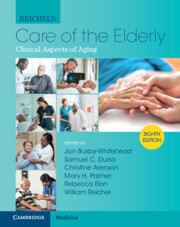Book contents
- Reichel’s Care of the Elderly
- Reichel’s Care of the Elderly
- Copyright page
- In Memoriam
- Contents
- Contributors
- Section I General Approach to the Care of the Elderly
- Section II Geriatric Syndromes
- Chapter 8 Frailty
- Chapter 9 Fall Prevention in Community-Dwelling Older Adults
- Chapter 10 Evaluation and Management of Dizziness
- Chapter 11 Evaluation and Management of Dementia
- Chapter 12 Recognition, Management, and Prevention of Delirium
- Section III Care of the Elderly by Organ System
- Section IV Principles of Care for the Elderly
- Index
- Plate Section (PDF Only)
- References
Chapter 10 - Evaluation and Management of Dizziness
from Section II - Geriatric Syndromes
Published online by Cambridge University Press: 30 June 2022
- Reichel’s Care of the Elderly
- Reichel’s Care of the Elderly
- Copyright page
- In Memoriam
- Contents
- Contributors
- Section I General Approach to the Care of the Elderly
- Section II Geriatric Syndromes
- Chapter 8 Frailty
- Chapter 9 Fall Prevention in Community-Dwelling Older Adults
- Chapter 10 Evaluation and Management of Dizziness
- Chapter 11 Evaluation and Management of Dementia
- Chapter 12 Recognition, Management, and Prevention of Delirium
- Section III Care of the Elderly by Organ System
- Section IV Principles of Care for the Elderly
- Index
- Plate Section (PDF Only)
- References
Summary
Dizziness and imbalance are common complaints in the elderly, with etiologies ranging from benign (e.g., benign paroxysmal positional vertigo) to potentially life-threatening (e.g., cerebellar stroke). Therefore, the stakes can be high and an organized and methodical approach to the history and examination is essential. The days of classifying based on the symptom quality alone – “dizzy,” “vertigo,” “lightheadedness” – are over, as this approach is often misleading and can result in an incorrect diagnosis. Instead, identifying the timing and onset, duration, triggers, and associated symptoms allows the clinician to substantially narrow the differential diagnosis. From the history, a focused examination is be performed depending on the clinical scenario (e.g., Dix-Hallpike for positional vertigo; the “HINTS” exam in the acute vestibular syndrome), and the most appropriate test(s) can then be selected when appropriate. In the elderly, there are many potential non-neuro-vestibular contributors that must also be considered (e.g., polypharmacy, blood pressure), and to complicate the history and examination further, dizziness and imbalance are often multifactorial. This chapter offers a practical step-by-step approach to the evaluation of elderly patients presenting with balance and vestibular disorders.
- Type
- Chapter
- Information
- Reichel's Care of the ElderlyClinical Aspects of Aging, pp. 102 - 111Publisher: Cambridge University PressPrint publication year: 2022



